インド: GLAQは低気圧性低酸素症による記憶障害を予防します
6月 2, 2020/防衛生理学研究所& 関連科学(インド)/科学レポート
文/呉廷耀
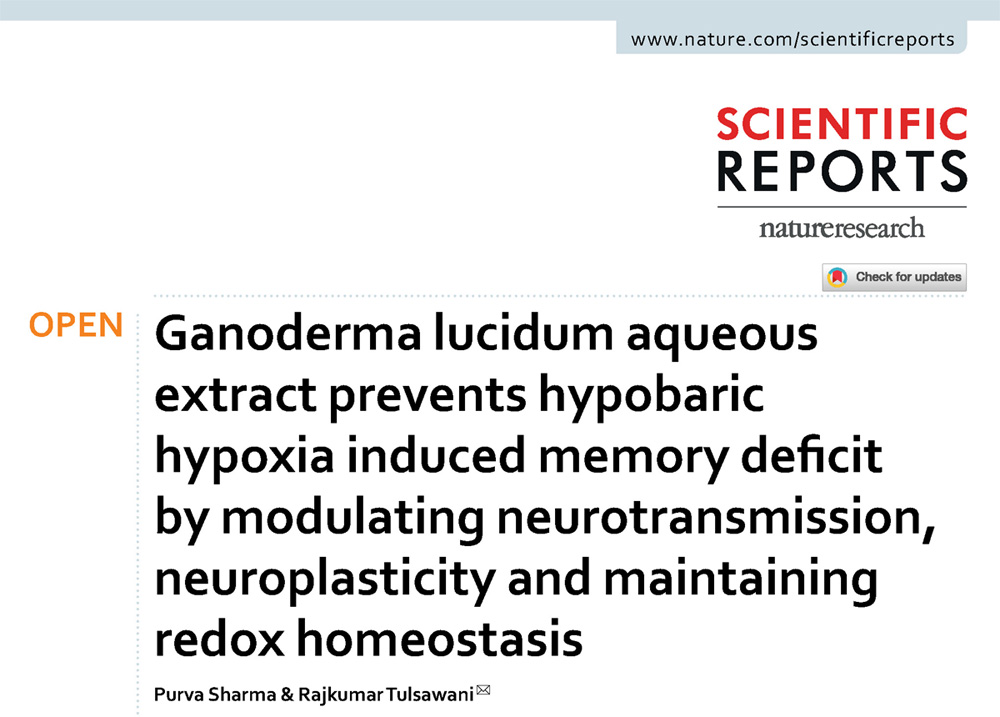
標高が高くなるほど, 空気圧が低いほど, 酸素が薄まるほど, 生理学的機能の作動に影響が大きくなるほど, 一般に知られているさまざまな健康リスクを引き起こす可能性が高くなります。 高山病.
これらの健康リスクは単なる頭痛の種になる可能性があります, めまい, 吐き気, 嘔吐, 疲労やその他の不快感, また、認知に影響を与える脳浮腫に発展することもあります。, モーター, そして意識機能, または呼吸機能に影響を与える肺水腫. 状況はどれほど深刻ですか? 休息後に徐々に回復するか、それともさらに悪化して不可逆的な損傷に至るか、生命を脅かす事態に至るかは、体内の組織細胞が外部の酸素濃度の変化に適応する能力にかかっています。.
高山病の発症や重症度は人によって異なります。, そしてそれは個人の体力に最も影響されます. 原則として, 以上の高度 1,500 meters (中高度) 人体に影響が出始める; 軽率に次の高度に達した健康な成人を含むすべての人 2,500 メートル以上 (高地) 身体が適応する前は問題が起こりやすい.
高所に登る慎重な計画を立てるか、出発前に予防薬を服用するか, 目的は体の適応力を高め、高山病の発生を防ぐことです。. しかし実際には, 別のオプションがあります, それはかかっていますマンネンタケ.
が発表した研究によると、 防衛生理学および関連科学研究所 (呼吸) 6月に 2020 科学レポートで, それがわかった マンネンタケ 水性抽出物 (グラク) 脳神経に対する低気圧性低酸素症の損傷を軽減し、空間記憶に関連する認知機能を維持することができます。.
水迷路– ラットの記憶能力をテストする良い方法
実験が始まる前に, 研究者らは数日をかけて、水面直下に隠されたプラットフォームを見つけるようラットを訓練した。. (形 1).
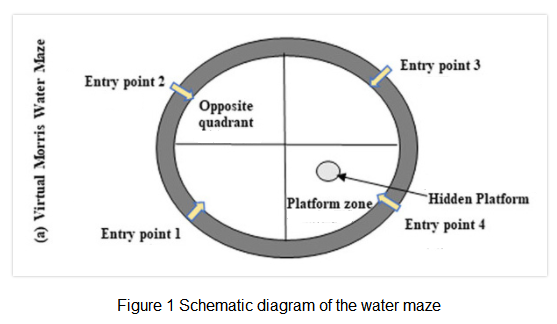
ネズミは泳ぎが得意です, しかし彼らは水が好きではありません, それで彼らは水を避けられる場所を見つけようとします.
図の水泳軌跡記録によると 2, 初日に数回回ってから6日目に直線に到達するまでに、ラットがプラットフォームを見つけるのがますます速くなったことがわかります。 (図の右 3 番目 2), 優れた空間記憶能力を持っていることを示しています.
プラットフォーム撤去後, ネズミの遊泳経路はプラットフォームが設置されていたエリアに集中していた (図の最初の右 2), これは、ラットがプラットフォームがどこにあったかを明確に記憶していたことを示しています.
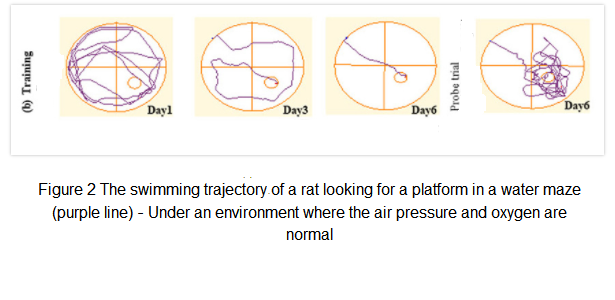
マンネンタケ 空間記憶に対する低気圧低酸素の影響を軽減します。
これらの訓練された正常なラットは 2 つのグループに分けられました. 1 つのグループは対照グループとして、通常の気圧と酸素の環境で生活を続けました。 (コントロール) 一方、もう一方のグループは低圧室に送られ、超高地での生活をシミュレートしました。 25,000 フィートかそれくらい 7620 低圧低酸素環境におけるメートル (HH).
低圧室に送られたラットの場合, そのうちの一部には、水性抽出物が与えられました。マンネンタケ (グラク) 1日あたりの用量で 100, 200, または 400 mg/kg (HH+GLAQ 100, 200, または 400) 一方、残りの部分には餌を与えられませんでしたマンネンタケ (HHグループ) 対照群として.
この実験は1週間続きました. 実験が終わった翌日, 5つのグループのラットを水迷路に入れて、プラットフォームの位置を覚えているかどうかを確認しました. 結果を図に示しました。 3:
コントロールグループ (コントロール) まだプラットホームの位置をはっきりと覚えていて、すぐにプラットホームを見つけることができました; 低圧室ラットの記憶能力 (HH) 著しく損なわれた, プラットフォームを見つけるのにかかる時間は対照群の 2 倍以上でした. しかし、低圧室の低酸素環境でも生きています。, GLAQを食べたラットはプラットフォームの記憶力が大幅に向上しました, そしてさらにマンネンタケ 彼らは食べました, 費やした時間は通常の対照群の時間に近かった.
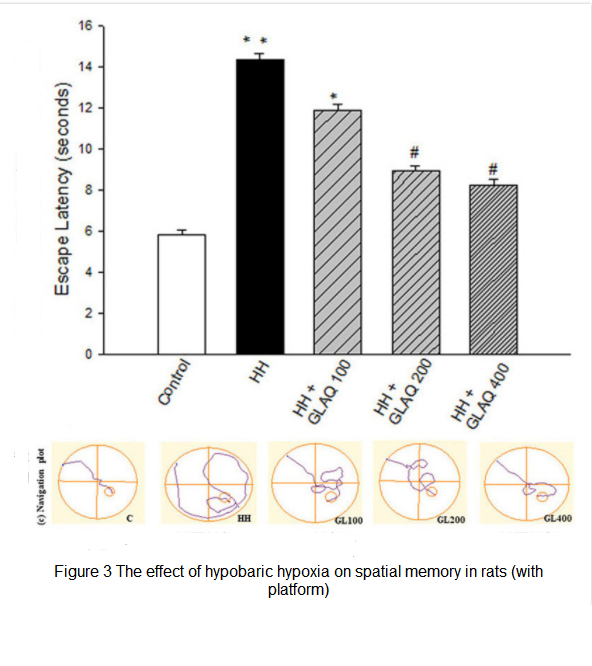
マンネンタケ 空間記憶に対する低気圧低酸素の影響を軽減します。
これらの訓練された正常なラットは 2 つのグループに分けられました. 1 つのグループは対照グループとして、通常の気圧と酸素の環境で生活を続けました。 (コントロール) 一方、もう一方のグループは低圧室に送られ、超高地での生活をシミュレートしました。 25,000 フィートかそれくらい 7620 低圧低酸素環境におけるメートル (HH).
低圧室に送られたラットの場合, そのうちの一部には、水性抽出物が与えられました。マンネンタケ (グラク) 1日あたりの用量で 100, 200, または 400 mg/kg (HH+GLAQ 100, 200, または 400) 一方、残りの部分には餌を与えられませんでしたマンネンタケ (HHグループ) 対照群として.
この実験は1週間続きました. 実験が終わった翌日, 5つのグループのラットを水迷路に入れて、プラットフォームの位置を覚えているかどうかを確認しました. 結果を図に示しました。 3:
コントロールグループ (コントロール) まだプラットホームの位置をはっきりと覚えていて、すぐにプラットホームを見つけることができました; 低圧室ラットの記憶能力 (HH) 著しく損なわれた, プラットフォームを見つけるのにかかる時間は対照群の 2 倍以上でした. しかし、低圧室の低酸素環境でも生きています。, GLAQを食べたラットはプラットフォームの記憶力が大幅に向上しました, そしてさらにマンネンタケ 彼らは食べました, 費やした時間は通常の対照群の時間に近かった.
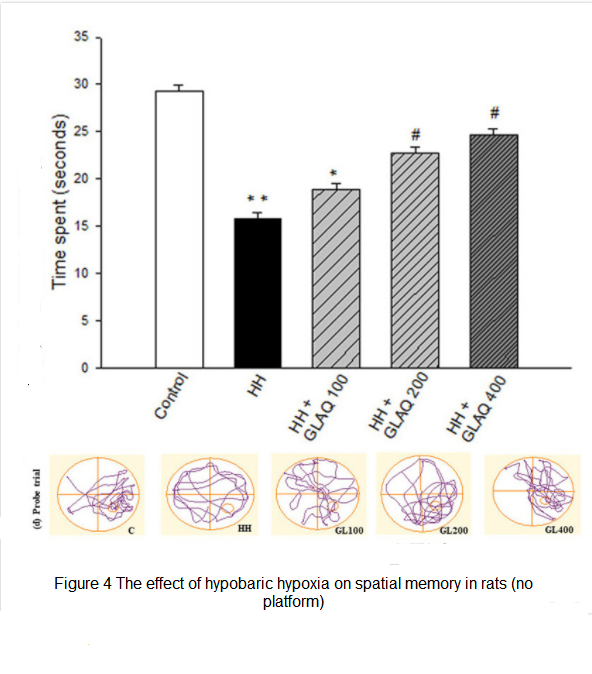
マンネンタケ 脳を保護し、脳浮腫と海馬回の損傷を軽減します。.
上記の実験結果は、マンネンタケ 低気圧低酸素症によって引き起こされる空間記憶障害を確かに軽減できる. 記憶機能は脳の構造と働きが正常かどうかの現れです. したがって, 研究者らは実験用ラットの脳組織をさらに解剖して分析した。, そしてそれを見つけました:
低圧低酸素は血管浮腫を引き起こす可能性があります (毛細血管の透過性が高まると、大量の体液が血管から漏れ、脳の間質空間に蓄積します。) そして海馬回 (記憶形成を担当する) ダメージ, しかし、これらの問題は、事前にGLAQを与えられたラットでは大幅に軽減されました (形 5 そして 6), それを示しているマンネンタケ 脳を守る効果がある.
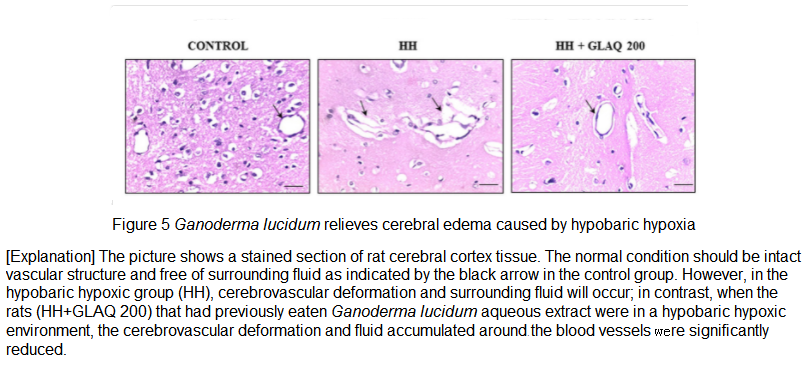
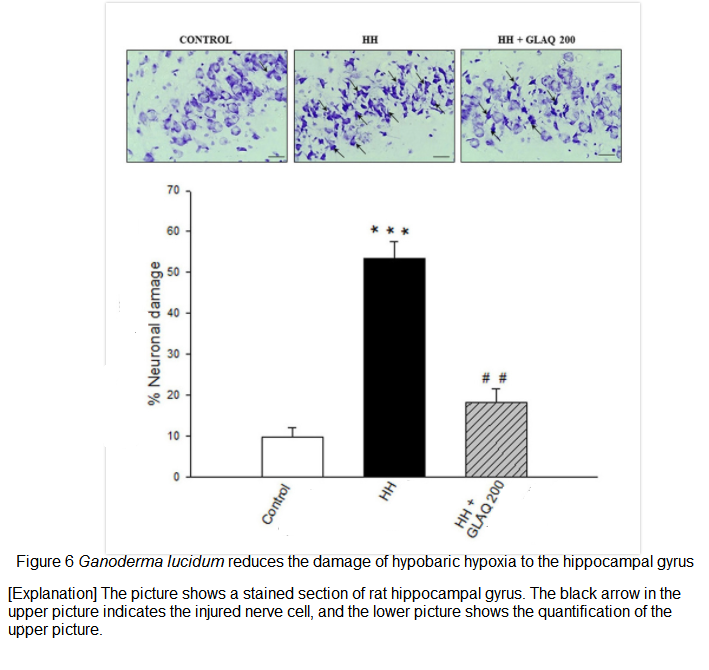
の仕組みマンネンタケ 低圧性低酸素症に対して
なぜマンネンタケ 水性抽出物は低圧低酸素による損傷に耐えることができます。? さらに詳細な議論を行った結果を図にまとめました。 7. 基本的に2つの一般的な方向性があります:
一方では, 低圧低酸素状態に適応する際の体の生理学的反応は、次の介入によりより速く、より良く調整されます。マンネンタケ; 一方で, マンネンタケ 抗酸化および抗炎症により脳神経細胞内の関連分子を直接調節できる, 体内の酸素を一定に保つ, 脳の神経回路を調整する, スムーズな神経伝達を維持し、神経組織と記憶能力を保護します。.
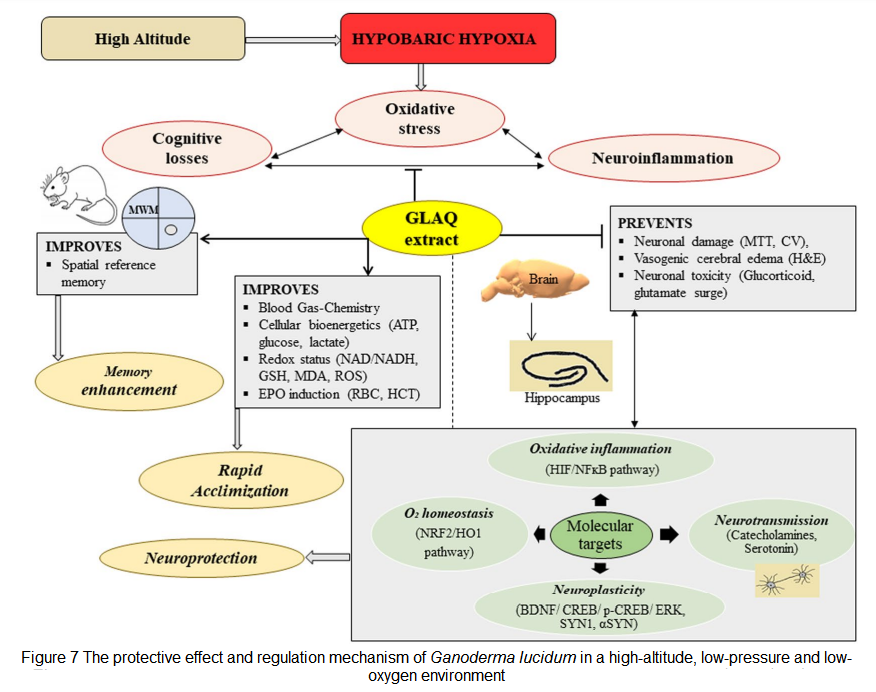
過去に, 多くの研究がそれを指摘していますマンネンタケ アルツハイマー病などのさまざまな側面から脳神経を保護することができます, パーキンソン病, てんかん, 血管塞栓症, 偶発的な脳損傷, そして老化. 今回インドで行われた研究により、次の証拠が追加されました。マンネンタケ高地から見た「知恵と記憶力の向上」, 低気圧と低酸素.
特に, 研究ユニット防衛生理学研究所& 関連科学 (呼吸) 防衛研究開発機構に所属 (DRDO) インド国防省の. 長年にわたり、高地生理学の分野で徹底的な研究を行ってきました。. 高地の環境や圧力に対する兵士の適応性と戦闘効率をいかに向上させるかが、常に注目の的となってきました。. これにより、この研究結果がより意味のあるものになります.
含まれている有効成分は、マンネンタケ この研究で使用された水性抽出物 GLAQ には多糖類が含まれています, フェノール, フラボノイド, およびガノデリン酸A. この研究を発表する前に, 研究者は、抽出物の90日間の亜慢性毒性試験を実施し、たとえその用量が 1000 mg/kg, 組織に悪影響を与えることはありません, ラットの臓器と成長. したがって, ~の最小有効量 200 上記の実験における mg/kg は明らかに安全です.
十分な準備ができて初めて、登山の楽しさを満喫し、スカイラインを間近に感じることができます。. 安全なものがあればマンネンタケ あなたを元気づけるために, もっと安全に願いを叶えられるはずです。
[ソース]
1. プルヴァ シャルマ, ラジクマール・トゥルサワニ. マンネンタケ 水性抽出物は神経伝達を調節することにより、低圧性低酸素症による記憶障害を防ぎます。, 神経可塑性と酸化還元ホメオスタシスの維持. 科学担当者. 2020; 10: 8944. オンラインで公開 2020 ジュン 2.
2. プルヴァ シャルマ, 他. の薬理効果 マンネンタケ 高地ストレス要因に対する抽出物とその亜慢性毒性評価. J フード バイオケム. 2019 12月;43(12):e13081.
終わり
著者について/Mさん. 呉廷耀
ウー・ティンヤオ氏は、以来、霊芝に関する直接の情報を報告し続けている。 1999. 彼女はの著者です霊芝による治癒 (4月に人民医学出版社に出版 2017).
★この記事は著者の独占的な許可を得て掲載されています.
★上記作品は転載禁止です, 著者の許可なく抜粋または他の方法で使用される.
★上記記載事項に違反した場合, 著者は関連する法的責任を追及します.
★この記事の原文はWu Tingyaoが中国語で執筆し、Alfred Liuが英語に翻訳しました。. 翻訳に齟齬があった場合 (英語) そしてオリジナル (中国語), 本来の中国人が勝つだろう. 読者に質問がある場合, 原作者に連絡してください, MS. 呉廷耀.



